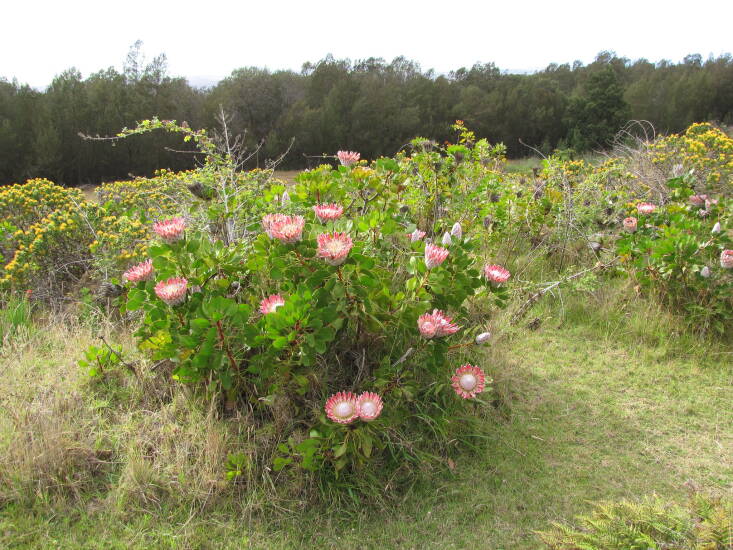King Protea, Protea cynaroides
I know you’ve seen this unusual and exotic flower at your local flower stand—the huge star-shaped, almost prehistoric looking flower that is so expensive you need to take out a loan just to purchase it. Well, good news. If you have a greenhouse or live where it is mild, you too can grow this king of all cut flowers.
Please keep reading to learn more about the fabulous and sought-after King Protea:

Native to the Cape Town part of South Africa (it’s actually the national flower), this evergreen woody shrub sports reddish stems and large spoon-shaped evergreen leaves and can grow to 3 to 5 feet high and 4 to 6 feet wide. But you really aren’t growing this plant because it is an attractive shrub—you are growing it for its oversized, striking flowers that burst forth in the autumn. The huge and long-lived 5- to 12-inch flowers are silky, with a mix of pale pink and darker crimson petals. Sometimes this plant blooms all the way to spring.
The Protea family, aptly named for the Greek god Proteus who could change between many forms, is known for its variety and diversity of plants. The epithet cynaroides refers to the genus Cynara (artichoke) in reference to a similar flower bud appearance.
The hardest part about growing this plant is that it needs to be protected from long periods of frost and temperatures dipping below 28 degrees F. If you live in areas afflicted by prolonged frost, consider growing this Protea in a protected greenhouse.
Sadly, nearly half of South Africa’s Protea species are facing extinction and very few exist in the wild anymore. Most are now cultivated in nurseries, greenhouses, arboretums and botanical gardens, and luckily here you can still admire and appreciate this kingly flower.
Cheat Sheet

- Incorporate this plant into a seaside garden as it can handle coastal conditions and has adapted to taking in moisture through its leaves.
- Looks perfect paired with its cousins Leucospermums and Leucadendrons. Palms, cacti, and succulents also combine well in a drought-tolerant garden.
- Makes a drool-worthy cut flower either used fresh or dried.
- Used in floral arrangements to symbolize courage, strength and diversity.
- Hungry deer luckily leave this plant alone.
- All parts are poisonous. Keep away from small children and curious pets.
Keep It Alive

- Plant in a very sunny spot to support full, even growth.
- Well-draining soil is critical. Acidic soil is preferable. Add horticultural sand or other gritty materials to improve drainage.
- Needs little irrigation once established.
- Avoid fertilization, as most contain phosphorus which in large quantities can harm or kill your Protea.
- Cut flowering stems back to base after flowering is complete.
See also:







Have a Question or Comment About This Post?
Join the conversation